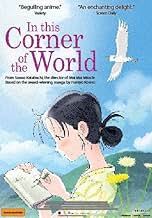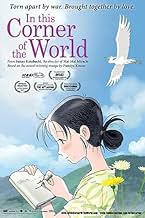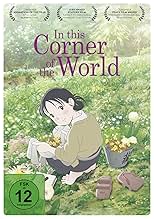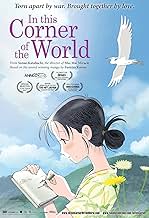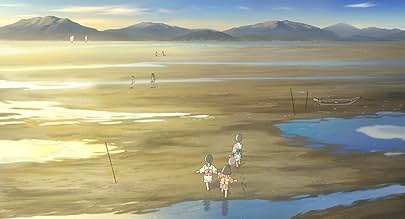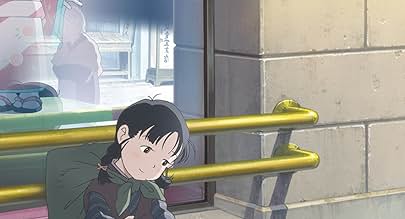PUNTUACIÓN EN IMDb
7,8/10
13 mil
TU PUNTUACIÓN
Ambientada en Hiroshima durante la segunda guerra mundial, una chica recién casada intenta preparar comida para su familia a pesar del racionamiento, y lucha por mantener la voluntad de vivi... Leer todoAmbientada en Hiroshima durante la segunda guerra mundial, una chica recién casada intenta preparar comida para su familia a pesar del racionamiento, y lucha por mantener la voluntad de vivir a pesar de la falta de comodidades básicas.Ambientada en Hiroshima durante la segunda guerra mundial, una chica recién casada intenta preparar comida para su familia a pesar del racionamiento, y lucha por mantener la voluntad de vivir a pesar de la falta de comodidades básicas.
- Dirección
- Guión
- Reparto principal
- Premios
- 10 premios y 11 nominaciones en total
Ava Pickard
- Suzu (Young)
- (English version)
- (voz)
Kenna Pickard
- Harumi
- (English version)
- (voz)
Karen Strassman
- Rin
- (English version)
- (voz)
Melodee Spevack
- Kiseno
- (English version)
- (voz)
Michael Sorich
- Juro
- (English version)
- (voz)
Tony Azzolino
- Yoichi
- (English version)
- (voz)
Anne Yatco
- Additional Voices
- (English version)
- (voz)
Bailey Bucher
- Additional Voices
- (English version)
- (voz)
Bryce Papenbrook
- Additional Voices
- (English version)
- (voz)
Cherami Leigh
- Additional Voices
- (English version)
- (voz)
Christopher Corey Smith
- Additional Voices
- (English version)
- (voz)
- (as Christopher Smith)
Cindy Robinson
- Additional Voices
- (English version)
- (voz)
Cristina Valenzuela
- Additional Voices
- (English version)
- (voz)
Dane Price
- Additional Voices
- (English version)
- (voz)
Dorothy Elias-Fahn
- Additional Voices
- (English version)
- (voz)
- (as Johanna Luis)
Joe Ochman
- Additional Voices
- (English version)
- (voz)
- (as Joseph Whimms)
Julie Ann Taylor
- Additional Voices
- (English version)
- (voz)
Reseñas destacadas
If you have chance to watch this movie, no matter what you must. And if you like it, you had better go looking ofor original manga book. I have been huge fan of original manga work but am still surprised the quality of this animation version. It was so true to original and yet what added has all tasty meanings. I found this masterpiece of animation as a rare case of triumph being transitioning media.
There have been few anime movies which have not left me deeply moved, and this is no exception. Mixing cute anime characters and their straightforward lives (at least on the surface) with the chaos and trauma of the Second World War may seem like an oversimplification of the war and a cheap, melodramatic effort at invoking sadness and tears, but there is a depth to the characters and emotions in this movie, and the ultimate message of the movie is not just that war is devastating and destroys the lives of countless innocents, but also that life moves on in spite of all the carnage, and people change and discover new qualities and things about themselves, transforming them into different (perhaps better?) versions of themselves.
The movie follows our female protagonist Suzu through her childhood to early marriage to the tumultuous years of the War. Suzu is a lovable and cheerful protagonist, gentle and kind but also clumsy and forgetful, redeemed by her artistic talent and her perseverance, but there are hidden depths to her that are only partially revealed through some odd sequences in the first part of the movie, and come into the spotlight in the second part after her traumatic brush with the War. The animation is beautiful, and the attention to detail is superb, transporting the viewer effortlessly to rural Japan in the 1940s. The cultural quirks of this place and era are delightfully presented in the first half of the movie, during which it feels like a gentle slice-of-life movie. Once the War begins in earnest, we see the effect that it has on the ordinary citizens. While there are some traumatic sequences, the movie does not linger on them, and instead it focuses on how the characters handle the changes and come to terms with them, often questioning the futility of all the devastation (especially after Japan loses the War) but also forging new bonds among each other and finding hidden depths in themselves.
One stark criticism of the movie is that some important supporting characters are not properly introduced, and Suzu's own feelings and desires are not properly explored, so that some revelations later on feel artificial and we never really entirely understand Suzu's actions and her motivations. Apparently, an extended version of the movie is being prepared which I feel is definitely required to understand this story in its full details.
The movie follows our female protagonist Suzu through her childhood to early marriage to the tumultuous years of the War. Suzu is a lovable and cheerful protagonist, gentle and kind but also clumsy and forgetful, redeemed by her artistic talent and her perseverance, but there are hidden depths to her that are only partially revealed through some odd sequences in the first part of the movie, and come into the spotlight in the second part after her traumatic brush with the War. The animation is beautiful, and the attention to detail is superb, transporting the viewer effortlessly to rural Japan in the 1940s. The cultural quirks of this place and era are delightfully presented in the first half of the movie, during which it feels like a gentle slice-of-life movie. Once the War begins in earnest, we see the effect that it has on the ordinary citizens. While there are some traumatic sequences, the movie does not linger on them, and instead it focuses on how the characters handle the changes and come to terms with them, often questioning the futility of all the devastation (especially after Japan loses the War) but also forging new bonds among each other and finding hidden depths in themselves.
One stark criticism of the movie is that some important supporting characters are not properly introduced, and Suzu's own feelings and desires are not properly explored, so that some revelations later on feel artificial and we never really entirely understand Suzu's actions and her motivations. Apparently, an extended version of the movie is being prepared which I feel is definitely required to understand this story in its full details.
A coming of age story set during WWII depicting the story of Suzu a girl forced to marry away from her home. Viewers may find parallels to 'Grave of the fireflies' another animated Japanese film depicting war time struggles of the ordinary people. In fact the struggles of the everyman(woman) is heavily featured in this story of a young girl in a fish out of water situation while maintaining her inherent innocence in spite of the horrors of war.
It is very interesting how through this character and the gentle animated artstyle a story of war depicting horrible imageries from bombings, to explosions, to death can all seem innocent and calm. A particular scene of explosions in the air transitions perfectly to colourful splatters of colours in the sky in the eyes of our protagonist. Her innocence and naivete is challenged throughout the film yet through the many challenges she faces yet it is maintained constantly.
What's great about this film is that because of such a characterisation her struggles to daily life often seems even on par to that of the horrors of war, focusing on the everyman's struggle is a new and innovative way of viewing war, struggles from finding her way and managing rations. Such a character seems almost the opposite of war and bloodshed as she sets the tone for this film which seems unlike one that focuses on war setting In this corner of the world apart from the bunch. Yet we still witness the character mature and grow throughout even though she doesn't lose her sense of imagination and innocence, it's a tough notion to balance and goes against traditional ideas in a coming of age tale where a main protagonist must understand the 'true colours' of society, the world, humanity in order to come to fruition. By doing so solidifying itself as a staple supporting that of peace and the good in being ordinary.
It is very interesting how through this character and the gentle animated artstyle a story of war depicting horrible imageries from bombings, to explosions, to death can all seem innocent and calm. A particular scene of explosions in the air transitions perfectly to colourful splatters of colours in the sky in the eyes of our protagonist. Her innocence and naivete is challenged throughout the film yet through the many challenges she faces yet it is maintained constantly.
What's great about this film is that because of such a characterisation her struggles to daily life often seems even on par to that of the horrors of war, focusing on the everyman's struggle is a new and innovative way of viewing war, struggles from finding her way and managing rations. Such a character seems almost the opposite of war and bloodshed as she sets the tone for this film which seems unlike one that focuses on war setting In this corner of the world apart from the bunch. Yet we still witness the character mature and grow throughout even though she doesn't lose her sense of imagination and innocence, it's a tough notion to balance and goes against traditional ideas in a coming of age tale where a main protagonist must understand the 'true colours' of society, the world, humanity in order to come to fruition. By doing so solidifying itself as a staple supporting that of peace and the good in being ordinary.
Greetings again from the darkness. There is something hypnotic about the hand-drawn animation of writer/director Sunao Katabuchi's film based on the 2007-09 Japanese manga (comic) by Fumiyo Kouno. With some similarities to Takahata's 1988 classic Grave of the Fireflies, it's more than a wartime drama – it's a story of the human spirit.
It's 1935 and Suzu is a young girl who lives in Eba, a town in Hiroshima. She is an exceptional artist with a vibrant imagination and an adventurous approach to life. Her innocence and pleasant childhood existence is rocked when, as a teenager, she receives an out-of-the-blue marriage proposal from a stranger. Life with his family in Kure forces Suzu into a daily routine of cleaning, mending and cooking – all while longing for her family in Eba.
The film clicks through the months and years, and provides a history of war time from the perspective of a family and village. While the date of August 6, 1945 hovers on the viewer's mind, we experience how family dynamics are affected by war time. For Suzu, her daily routines such as food preparation provide a necessary structure and distraction, despite the ever-worsening shortage of food and supplies. These stresses are compounded by air raid warnings over the radio and Suzu suffers through vivid nightmares.
We so easily connect with Suzu as she continually fights through hardships – both physical and emotional – because of her determination to live a good life and overcome all obstacles. This is such expert story telling with a beautiful presentation, that the film periodically reminds us that war is close by. Even in a war torn country, the people must find a way to go about daily life while treasuring the rare moments of joy and understanding the strength of togetherness. It's rare that an animated movie can deliver such a humanist look at fully formed characters and their feelings all within a historical setting.
It's 1935 and Suzu is a young girl who lives in Eba, a town in Hiroshima. She is an exceptional artist with a vibrant imagination and an adventurous approach to life. Her innocence and pleasant childhood existence is rocked when, as a teenager, she receives an out-of-the-blue marriage proposal from a stranger. Life with his family in Kure forces Suzu into a daily routine of cleaning, mending and cooking – all while longing for her family in Eba.
The film clicks through the months and years, and provides a history of war time from the perspective of a family and village. While the date of August 6, 1945 hovers on the viewer's mind, we experience how family dynamics are affected by war time. For Suzu, her daily routines such as food preparation provide a necessary structure and distraction, despite the ever-worsening shortage of food and supplies. These stresses are compounded by air raid warnings over the radio and Suzu suffers through vivid nightmares.
We so easily connect with Suzu as she continually fights through hardships – both physical and emotional – because of her determination to live a good life and overcome all obstacles. This is such expert story telling with a beautiful presentation, that the film periodically reminds us that war is close by. Even in a war torn country, the people must find a way to go about daily life while treasuring the rare moments of joy and understanding the strength of togetherness. It's rare that an animated movie can deliver such a humanist look at fully formed characters and their feelings all within a historical setting.
Suzu is a young girl living in a peaceful seaside Japanese city. It's revealed to be pre-war Hiroshima. Her family farms seaweed. At 18, she receives a marriage proposal from a relative stranger, a young earnest man from Kure who fell in love with her at first sight. She marries and moves in with his family. Kure is a Navy town and everybody works at the base. As food gets rationed, she finds ways to adapt. She continues to draw and is beloved by her adoring niece Harumi. The winds of war blow harsh as life grows ever more difficult.
The animation is simply beautiful which contrast nicely with the fear of impending doom. I really liked not naming Hiroshima at first. I'm sure everybody in Japan noticed the building right away but outside Japan, the audience may not catch on. It would be more compelling to stay silent on the city name longer. I actually expected more of a love triangle especially with that amazing sea rabbit drawing. It didn't turn out that way which is perfectly fine. I grew to like Shusaku which is exactly what Suzu does. There are some devastating drama but it also leave some heart-warming turns for the audience. Hiroshima is handled with class. It's Fireflies without the unrelenting depression.
The animation is simply beautiful which contrast nicely with the fear of impending doom. I really liked not naming Hiroshima at first. I'm sure everybody in Japan noticed the building right away but outside Japan, the audience may not catch on. It would be more compelling to stay silent on the city name longer. I actually expected more of a love triangle especially with that amazing sea rabbit drawing. It didn't turn out that way which is perfectly fine. I grew to like Shusaku which is exactly what Suzu does. There are some devastating drama but it also leave some heart-warming turns for the audience. Hiroshima is handled with class. It's Fireflies without the unrelenting depression.
¿Sabías que...?
- CuriosidadesWith a runtime of 168 minutes, the extended version is the longest animated film ever produced.
- Versiones alternativasA rumoured extended version, supposedly titled "Kono Sekai no (Sara ni Ikutsumono) Katsumi ni" ("In This Corner (and Other Corners) of the World"), has supposedly ~30 minutes of additional footage, that is reported to emphasize the relationship between Rin, Shusaku and Suzu. Slated to premiere in mid-December 2019.
- ConexionesFeatured in In This Corner: Then and Now (2017)
- Banda sonorakanashikite yarikirena
by Kotringo
Selecciones populares
Inicia sesión para calificar y añadir a tu lista para recibir recomendaciones personalizadas
- How long is In This Corner of the World?Con tecnología de Alexa
Detalles
- Fecha de lanzamiento
- País de origen
- Sitios oficiales
- Idioma
- Títulos en diferentes países
- In This Corner of the World
- Empresas productoras
- Ver más compañías en los créditos en IMDbPro
Taquilla
- Recaudación en Estados Unidos y Canadá
- 172.147 US$
- Fin de semana de estreno en EE. UU. y Canadá
- 24.205 US$
- 13 ago 2017
- Recaudación en todo el mundo
- 19.496.308 US$
- Duración
- 2h 9min(129 min)
- Color
- Mezcla de sonido
- Relación de aspecto
- 1.85 : 1
Contribuir a esta página
Sugerir un cambio o añadir el contenido que falta







